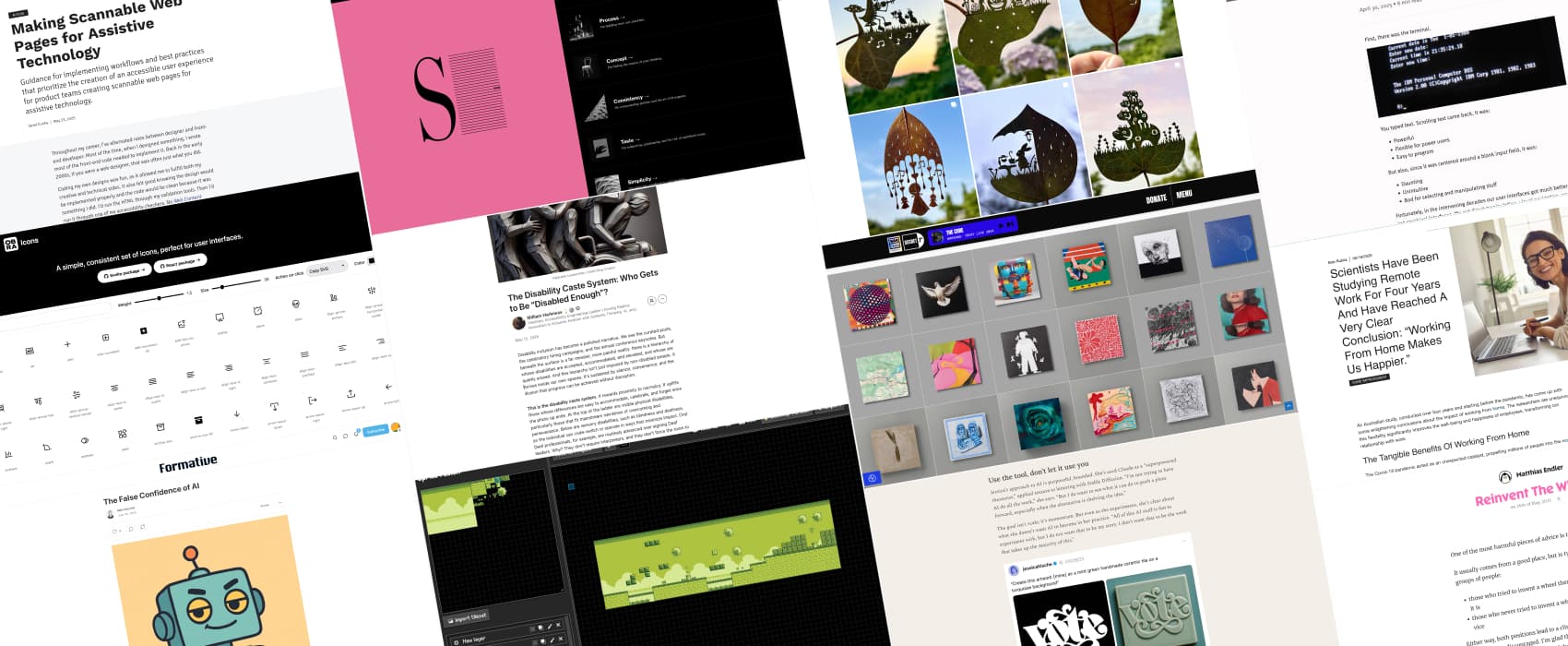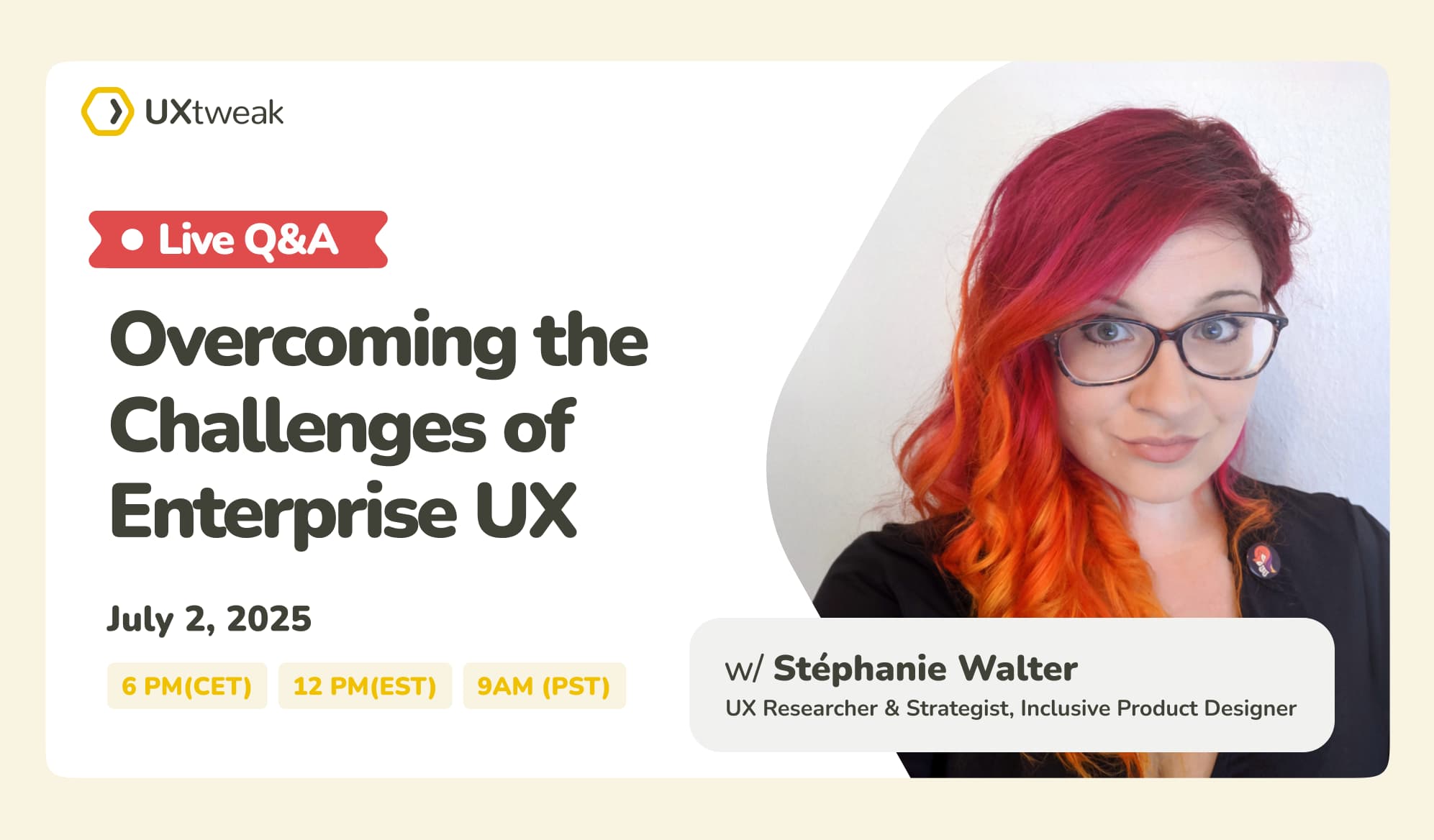
Pixels of the Week – June 22, 2025
False confidence in AI, a fun game level editor and some free icons
My curated weekly-ish online newsletter, where I share interesting articles, tools, and resources I found during the week. You can expect content about UX, design, user research, accessibility & tech, but also some processes, some inspiration, sometimes books, and a couple of videos and podcasts. Also, don’t forget to, subscribe to the newsletter to get notified, you will get the weekly links directly in your mailbox, and be notified when I publish other articles.
Now: what I’m currently up to
Save the date: July 2, 6PM GMT+2 I’ll be live to talk about challenges of Enterprise UX with UXtweak. Come with your questions, on how to design systems and software that not only work but also create a positive employee experience across complex, large-scale environments.
UXLibs Wrap Up
I had an amazing time at UXLibs: the energy, the people, the conversation, the organization, everything was so brilliant! I was nervous about being a keynote speaker for the first time but it went super well. Librarians are such lovely people.
I spoke about making libraries more accessible for everyone, especially people with invisible disabilities. It’s also a topic very close to my heart, as a neurospicy book warm! It all went really well, very nice feedback. I’m considering turning the talk into an article soon, so let me know if that’s something you’d be interested in.
The “Accessibility Journey Mapping for More Inclusive Libraries” workshop was another highlight. It was challenging to speed-run a journey map in just one hour, but the groups were incredible. I got very nice feedback about the content, but also my Accessibility barrier cards. It’s a deck of cards I created to highlight accessibility barriers was particularly well received. Participants said it helped them consider different types of disabilities throughout a whole journey. The tool still needs some refinement, and I want to explore how it might be adapted beyond libraries, maybe for public spaces like museums or cinemas too.
The team challenge during the conference was a great way to bond and create something tangible together. I had a lot of fun, and I also loved the craft table filled with stickers, shiny gems, and all things stickable to decorate our badges. Every conference should have this.
I 100% recommend this conference if you work in UX for libraries! A massive thank you to Andy Priestner, Bryony Ramsden, Marisa Priestner, Julie Willems, and Andrew Alexander for the incredible organization. To Amy Theobald for the most entertaining housekeeping announcements ever. And to my panel partner in crimes Venessa Bennett and Joel McGeorge, I think we did a great job under the grilling questions!
Interesting articles that caught my attention
The Disability Caste System: Who Gets to Be “Disabled Enough”? (6min) Disability inclusion often favors people who don’t need many changes, creating a system where being “easy to work with” matters more than real access. Real equity means including all disabled people. Not just the ones who fit into a comfortable story! by William Harkness
Scientists have been studying remote work for four years and have reached a very clear conclusion: “Working from home makes us happier.” (5min). A 4-year Australian study found that remote work boosts happiness, health, and productivity. Especially when chosen. It saves time, improves sleep, diet, and work-life balance. Yet, we are all being forced to come back to the office. Go figures?
Post-Chat UI (12min) AI is changing how we use apps, with new UI patterns, like natural search in full text, contextual menus, side panels. You can type what you want instead of picking from lists. AI can clean things up, give feedback, and suggest what to do next. The new UI patterns are quite interesting. By Allen Pike
Reinvent the Wheel (8min) Don’t reinvent the wheel” is lazy advice. Reinventing helps you learn, find flaws, and maybe build something better. Wheels got better because people reinvented them. So be curious, break stuff, and build your own version. That’s how you grow. By Matthias Endler
A designer’s guide to engaging with AI – by Carly Ayres (7min) Jessica Hische argues that designers shouldn’t ignore AI. They should engage with it critically and creatively to understand its limits, protect their value, and preserve the irreplaceable human touch in their work. AI might be fast and flashy, but the soul of design lies in intention, imperfection, and the visible hand of the maker. I loved that interview! By Carly Ayres
The False Confidence of AI (5min) Ron Goldin shares a couple of interesting examples where AI completely made things up. And admitted to it, one pressed, like a 6 year old admitting they took too much candy. To actually trust AI, we need it to admit when it’s clueless, not gaslight us with polished nonsense wearing a helpful smile, thinking it has access to a Figma file, while it’s making it all up. Ron’s advice: test your setup, to make sure things work properly, before asking the AI to run more complex tasks.
Inspiration: fun experiments, beautiful art, and great ideas
2025 Gallery – Secret 7” 700 selected sleeve design, if you like music and design, you should love this
Lito_leafart on Instagram you need some cute leaf art in your life this week, trust me. Lito is a leaf cutting artist based in Japan, who uses his, biased concentration due to ADHD to create those.(also Lito leaf’s website)
Useful tools & resources
Sprite Fusion for my game designer and pixel art lover friends, a free level design tool to craft beautiful 2D tilemaps right in your browser using any tileset. Import your tileset and have fun!
DOC • Syntax a collection exploring concepts, around design, including craft, process, consistency, taste, etc.
Obra Icons, a simple, consistent set of icons, perfect for user interfaces, that is free and open source.
Tutorials
Making Scannable Web Pages for Assistive Technology (20min) a great tutorial by Jared Cunha to understand how a screen reader will read the page, with different options (landmarks, titles, forms, etc). This also emphases why, a proper semantical HTML structure is crucial for accessibility.
The Role of Captions and Transcripts in Accessibility (8min) Why you need captions, who they help, and some practical advice on how to build good captions and transcripts into your product, by Michael Beck
Latest news in the industry
So, you screwed up your EAA compliance. What now? (9min) If your site or app won’t meet EAA rules by June 28, 2025, you still risk fines. But you can avoid them by showing real effort, flexibility is built in the process. Start fixing issues, focus on key features, document progress, and get expert to help you.

